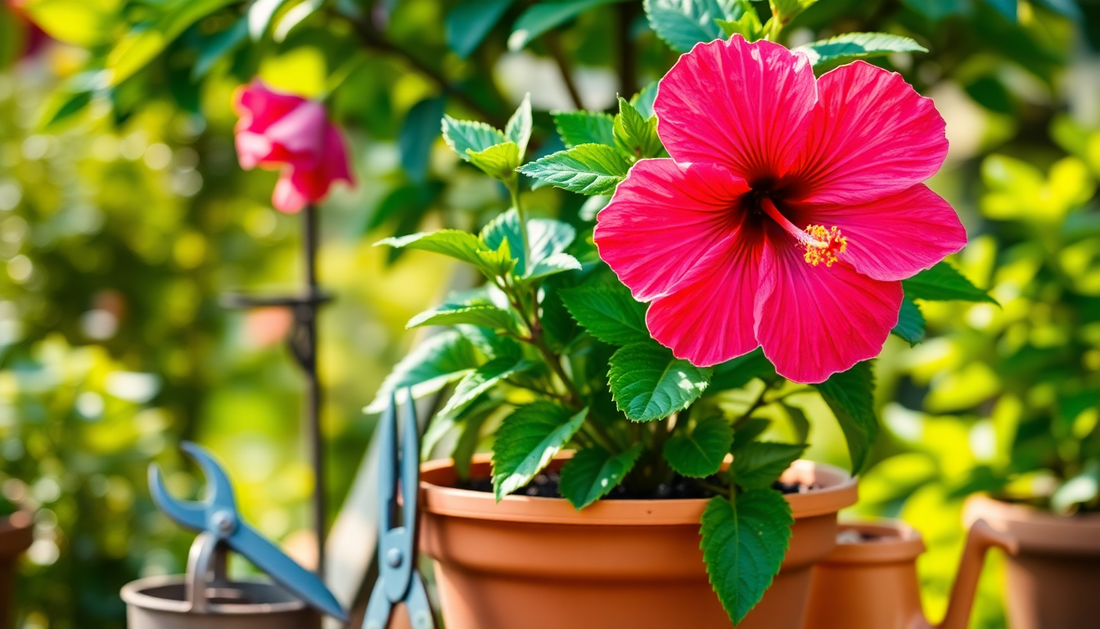
Unlocking the Beauty: A Guide to Caring for Hibiscus Plants in Pots
Share
Hibiscus plants, with their vibrant and captivating blooms, have long been a beloved addition to gardens and homes around the world. Whether you're a seasoned gardener or a beginner, growing these tropical beauties in pots can be a rewarding and enjoyable experience. In this comprehensive guide, we'll delve into the intricacies of caring for hibiscus plants in pots, ensuring your garden or indoor oasis is filled with their stunning flowers.
Choosing the Right Pot and Soil
The foundation of a thriving hibiscus plant starts with the right pot and soil. When selecting a container, opt for one that is at least 12 inches in diameter and has ample drainage holes. Hibiscus plants have robust root systems, so a deep pot is essential to accommodate their growth. As for the soil, choose a well-draining, nutrient-rich potting mix specifically formulated for flowering plants. Avoid using regular garden soil, as it may not provide the necessary drainage and aeration for your hibiscus.
Soil pH and Nutrient Requirements
Hibiscus plants thrive in slightly acidic soil, with a pH range of 5.5 to 6.5. If your soil is too alkaline, you can amend it by adding sulfur or peat moss to lower the pH. Additionally, hibiscus plants are heavy feeders, so it's important to provide them with a balanced, slow-release fertilizer or a water-soluble fertilizer every two to three weeks during the growing season.
Watering and Sunlight Needs
Proper watering is crucial for the health and longevity of your hibiscus plants. These tropical beauties prefer consistently moist soil, but be careful not to overwater. Water your hibiscus when the top inch of soil becomes dry, and be sure to provide adequate drainage to prevent waterlogging. During the hot summer months, you may need to water more frequently to keep the soil from drying out.
Sunlight Requirements
Hibiscus plants thrive in full sun, requiring at least six hours of direct sunlight per day. If you're growing your hibiscus indoors, place it in a south-facing window or consider using a grow light to ensure it receives the necessary light exposure.
Pruning and Deadheading
Regular pruning and deadheading are essential for maintaining the shape and continued blooming of your hibiscus plants. After the flowers have faded, use clean, sharp pruners to remove the spent blooms. This encourages the plant to direct its energy into producing new flowers.
Shaping and Rejuvenation Pruning
To keep your hibiscus plant looking its best, prune it lightly throughout the growing season to maintain its shape and encourage bushier growth. Additionally, consider performing a more extensive rejuvenation prune in late winter or early spring, cutting the plant back by about one-third to stimulate new growth and prevent it from becoming leggy.
Overwintering and Cold Protection
Hibiscus plants are tropical in nature and can be sensitive to cold temperatures. If you live in a climate with harsh winters, it's essential to provide your potted hibiscus with the appropriate cold protection. During the colder months, move your plant indoors to a sunny location, such as a south-facing window or a greenhouse, and reduce watering to prevent root rot.
Dormancy and Pruning
When overwintering your hibiscus, it's normal for the plant to go into a dormant state, with reduced growth and leaf drop. During this time, continue to water sparingly and avoid heavy pruning. Once spring arrives and new growth begins to emerge, you can resume your regular watering and pruning routine.
Troubleshooting Common Issues
Even with the best care, your hibiscus plant may encounter some challenges. Keep an eye out for common issues such as pests, disease, and nutrient deficiencies, and address them promptly to ensure the continued health and vitality of your plant.
Pest Management
Aphids, mealybugs, and spider mites are common pests that can affect hibiscus plants. Use a gentle, insecticidal soap or neem oil to control these pests, and be sure to inspect your plant regularly for any signs of infestation.
Disease Prevention
Fungal diseases, such as powdery mildew and leaf spot, can also plague hibiscus plants. Maintain good air circulation around your plant, and avoid getting the leaves wet when watering to help prevent the spread of these diseases.
Enjoying the Blooms
With the right care and attention, your potted hibiscus plant will reward you with a stunning display of vibrant flowers throughout the growing season. Take the time to admire the beauty of these tropical wonders, and share your passion for gardening with friends and family. Embrace the joy of nurturing these captivating plants, and let their enchanting blooms transform your outdoor or indoor space into a true oasis of natural beauty.
